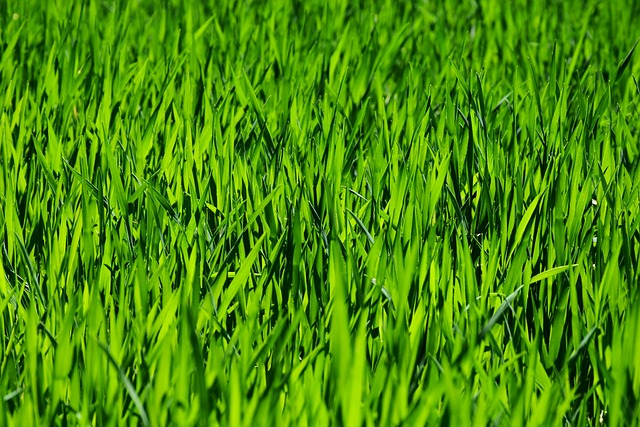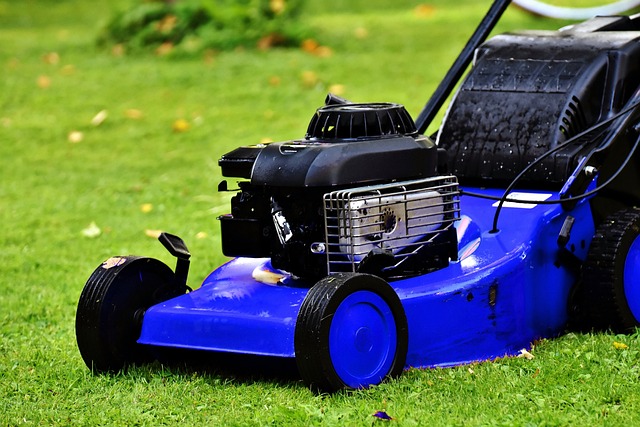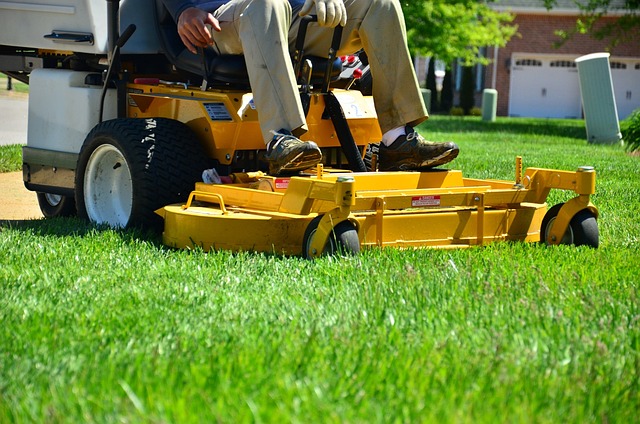Lawn care and landscaping are essential practices for maintaining an attractive and functional outdoor space, free of pests like grubs or chinch bugs, which can be identified by their brown patches. Effective management involves careful pesticide application, adhering to safety guidelines and local regulations. Soil compaction, a common issue due to foot traffic or machinery, should be addressed through aeration, which allows for better air, water, and nutrient flow to the roots, while overseeding with suitable grass types can enhance lawn resilience. Thatch management is also crucial; it's a layer of organic matter that, if not properly maintained through regular aeration and maintenance, can hinder turf health by impeding gas exchange and water absorption, and create conditions for pests and diseases. Weed control is another key aspect, requiring a combination of maintaining a thick, dense grass cover to naturally compete against weeds, and using pre-emergence herbicides in spring and fall to prevent weed seed germination, along with post-emergence treatments for existing weeds. The choice of grass type—whether cool-season or warm-season—dictates the specific lawn care and landscaping practices needed to ensure a healthy, robust, and visually appealing lawn throughout the year. Tailoring these practices to local climate conditions and adhering to best practices in lawn care ensures an environmentally sustainable and aesthetically pleasing landscape.
Maintaining a lush, vibrant lawn is a quintessential aspect of landscaping that enhances both property value and overall curb appeal. However, even the most dedicated gardeners face common lawn care challenges, such as thatch buildup, weed infestations, and varied grass types with distinct upkeep needs. This article delves into these issues, providing actionable solutions to help you overcome these obstacles and achieve your dream lawn. From understanding how to identify and address lawn problems to mastering the art of weed prevention and learning about different grass varieties’ specific care requirements, ‘Lawn Care And Landscaping’ is your comprehensive guide to a flourishing outdoor space.
- Identifying Common Lawn Care Challenges: A Guide to Recognizing and Addressing Them
- Thatch Accumulation: Causes, Consequences, and Effective Management Techniques
- Dealing with Weeds: Strategies for Prevention and Eradication in Your Lawn
- Grass Varieties and Their Specific Care Requirements for Optimal Growth and Aesthetics
Identifying Common Lawn Care Challenges: A Guide to Recognizing and Addressing Them

A well-maintained lawn serves as a beautiful and inviting landscape for any property. However, lawn care and landscaping can present various challenges that require diligent attention and informed solutions. One common issue is turfgrass pests, such as grubs or chinch bugs, which can cause significant damage to the grass. To identify these pests, watch for irregular-shaped brown patches in the lawn that contrast with healthy green areas. These infestations can be managed by applying appropriate pesticides; however, it’s crucial to follow safety guidelines and local regulations when using such products.
Another challenge is soil compaction, which can hinder root growth and water absorption. This often occurs in areas with high foot traffic or after heavy machinery use. To assess soil compaction, push a screwdriver or a spike into the ground; if it goes in easily without much resistance, compacted soil may not be an issue. For treatment, consider aeration, which helps to alleviate compaction by creating space for air, water, and nutrients to reach the roots. Additionally, overseeding with desirable grass varieties can enhance lawn density and resilience against future compaction issues. Lawn care and landscaping require an understanding of these challenges and proactive measures to maintain a healthy, vibrant lawn. Regular monitoring, combined with timely interventions, are key to overcoming the various problems that can affect your outdoor spaces.
Thatch Accumulation: Causes, Consequences, and Effective Management Techniques

Thatch accumulation is a prevalent issue in lawn care and landscaping that can hinder the health and aesthetic appeal of your turf. This layer of dead and living grass stems, roots, and other organic matter builds up between the soil surface and the live grass blades. It’s formed as grass grows at a faster rate than the decomposition processes can break it down. Excessive thatch can suffocate the lawn, prevent water and nutrient uptake, and provide an environment conducive to disease and pest infestations. To manage thatch effectively, regular lawn care practices are essential. Aerating your lawn several times a year helps to alleviate compaction, allowing air, water, and fertilizer to penetrate the soil more easily. Additionally, choosing the right grass varieties for your climate and soil conditions can reduce thatch buildup. When thatch becomes too thick, vertical mowing, also known as dethatching, can be performed to cut through the thatch layer. This should be done with caution, as over-dethatching can damage the living grass blades. Regular raking or verticutting during the growing season, along with proper watering and fertilization practices, will support a thick, healthy lawn that minimizes thatch accumulation.
In terms of landscaping, understanding the conditions that lead to thatch formation is key to maintaining an attractive and functional outdoor space. Soil compaction, improper irrigation, and high-traffic areas are common culprits. A well-designed landscape incorporates elements that reduce these issues, such as proper drainage, diverse plantings to spread traffic, and open spaces for air movement. By combining effective lawn care strategies with thoughtful landscaping design, you can create a resilient and beautiful outdoor environment that’s both functional and sustainable.
Dealing with Weeds: Strategies for Prevention and Eradication in Your Lawn

Maintaining a lush, healthy lawn often requires vigilance against weeds, which can quickly overtake your grass if left unchecked. Effective weed prevention is a key component of comprehensive lawn care and landscaping strategies. To prevent weeds from taking root, maintain a thick, dense turf that outcompetes them for light, water, and nutrients. This involves regular mowing at the correct height for your lawn species, consistent watering, and fertilization tailored to your soil’s needs. Aerating your lawn periodically also improves soil quality and encourages grass growth, making it less hospitable for weed seeds.
When weeds do appear, addressing them promptly is crucial. There are various methods for their eradication, including manual removal, which involves pulling or digging out weeds before they seed. For broader infestations, cultural practices such as proper irrigation and mowing can be supplemented with pre-emergence herbicides applied in the spring and fall to prevent germination. Post-emergence herbicides can target existing weeds without harming your grass when used correctly and according to product labels. It’s important to identify the type of weed you’re dealing with, as different species may require specific treatments. Always follow safety guidelines when handling any chemical treatments, and consider integrating environmentally friendly practices like mulching and introducing beneficial insects where possible within your lawn care and landscaping efforts. By staying proactive and informed, you can keep your lawn looking its best all year round.
Grass Varieties and Their Specific Care Requirements for Optimal Growth and Aesthetics

When cultivating a lush and vibrant lawn, selecting the appropriate grass variety is paramount for optimal growth and aesthetic appeal. Different grass species thrive under distinct environmental conditions and have unique care requirements. For instance, cool-season grasses like Kentucky bluegrass and fescues excel in regions with cold winters and moderate summers. They perform best with regular watering and aeration during their active growth periods in spring and fall. In contrast, warm-season grasses such as Bermuda, Zoysia, and St. Augustine grass flourish in hotter climates, requiring less water and more sunlight. They fare better with heavy feeding during the growing season and over-seeding in late summer or early fall to maintain their density and resilience.
Understanding the specific needs of each grass type is essential for lawn care and landscaping. For example, Kentucky bluegrass may benefit from a soil pH between 6.0 and 7.5, while Zoysia grass prefers a slightly higher pH range of 6.5 to 7.5. Aeration practices also vary; cool-season lawns might need aeration in the fall or spring to alleviate compaction, whereas warm-season lawns may require it during the growing season to ensure adequate oxygen and nutrient supply to the roots. Lawn care and landscaping practices should be tailored to the type of grass present, ensuring a healthy, green, and sustainable landscape that withstands local climate challenges and enhances the overall aesthetic appeal of your property.
Effective lawn care and landscaping hinge on recognizing common challenges and implementing targeted solutions. This article has shed light on prevalent issues such as thatch buildup, weed infestations, and the varying needs of different grass varieties. By understanding these elements and applying the recommended strategies, homeowners can foster a lush, thriving lawn. Addressing thatch accumulation promptly prevents soil compaction and disease, while a proactive approach to weed management ensures a uniform turf free of intrusive plants. Tailoring care to suit the specific requirements of your chosen grass type is essential for achieving both aesthetic appeal and environmental resilience. With these insights into lawn care and landscaping, you’re now equipped to maintain a verdant outdoor space that complements any landscape setting.
